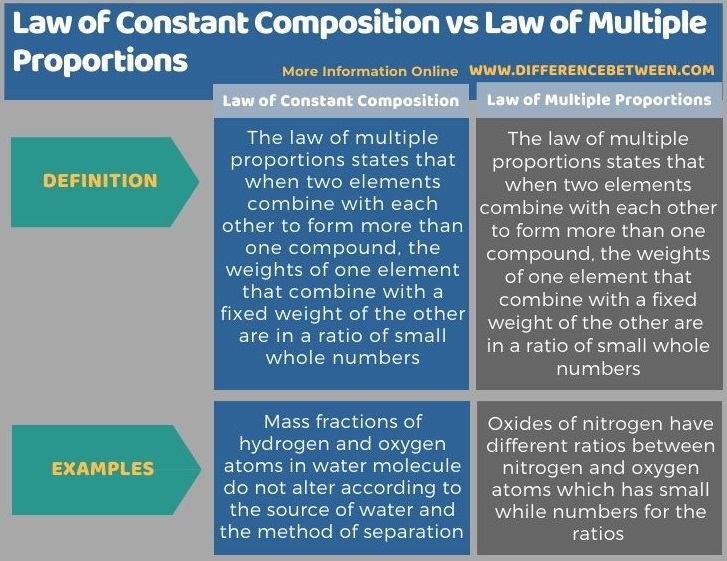Difference Between Law of Constant Composition and Law of Multiple Proportions
Table of Contents
The key difference between law of constant composition and law of multiple proportions is that according to the law of constant composition, the same proportion of samples always consists of the same proportion of elements by mass, whereas according to the law of multiple proportions, if two elements bind with each other forming more than one chemical compound, then the ratio between the masses of the second element that combines with a fixed mass of the first element has ratios of small whole numbers.
The law of constant compositions and law of multiple proportions are theories in physical chemistry that are used to explain stoichiometry in chemistry. Stoichiometry is the measure of the relative quantities of reactants and products in a chemical reaction.
CONTENTS
1. Overview and Key Difference
2. What is Law of Constant Composition
3. What is Law of Multiple Proportions
4. Side by Side Comparison – Law of Constant Composition vs Law of Multiple Proportions in Tabular Form
5. Summary
What is Law of Constant Composition?
The law of constant composition states samples of a compound will always contain the same proportion of elements by mass. We can name this law as the law of definite proportions as well. This law describes that a given compound will always contain the same elements in the same proportions by mass.
For example, be it tap water or seawater, a water molecule will always contain hydrogen and oxygen elements in the following proportions. The chemical formula of a water molecule is H2O, and the molar mass of this molecule is 18 g/mol. Therefore, one mole of water contains 18 g of H2O. The ratio between H and O in the water molecule is 2:1. Accordingly, the mass fraction of hydrogen in water = (2g / 18g) x 100% = 11.11% and the mass fraction of oxygen = (16g/18g) x 100% = 88.89%. These fractions are constant and do not alter according to the source of water and the method of separation.
The law of constant composition depends on the fact that any atom of the same element (atoms having the same atomic number) is similar to each other. Considering the above example, the assumption is that any hydrogen atom is similar to another hydrogen atom and vice versa. But there can be some exceptions as well. E.g. the isotopic composition of an element can vary depending on the source. Therefore, stoichiometry shows variations depending on the source of elements.
What is Law of Multiple Proportions?
The law of multiple proportions states that when two elements combine with each other to form more than one compound, then the weights of one element that combine with a fixed weight of the other are in a ratio of small whole numbers.

We can call this law Dalton’s law as well because the law was developed by John Dalton in 1803. Let us understand this law using an example.
Oxides of nitrogen consist of nitrogen and oxygen atoms. We can identify five different oxides of nitrogen that exist: N2O, NO, N2O3, NO2 and N2O5. Considering the mass ratios of N and O in these oxide compounds, 14 grams of nitrogen atom combines with 8, 16, 24, 32 and 40 grams of oxygen according to the mass ratio, respectively. If we take these numbers as small, whole numbers, then the ratios can be given as 1:1, 1:2, 1:3, 1:4 and 1:5.
What is the Difference Between Law of Constant Composition and Law of Multiple Proportions?
According to the law of constant composition, the same proportion of samples always consists of the same proportion of elements by mass, whereas according to the law of multiple proportions, if two elements bind with each other forming more than one chemical compounds, then the ratio between the masses of the second element that combines with a fixed mass of the first element has ratios of small whole numbers. So, this is the key difference between law of constant composition and law of multiple proportions.

Summary – Law of Constant Composition vs Law of Multiple Proportions
According to the law of constant composition, the same proportion of samples always consists of the same proportion of elements by mass, whereas according to the law of multiple proportions, if two elements bind with each other forming more than one chemical compounds, then the ratio between the masses of the second element that combines with a fixed mass of the first element has ratios of small whole numbers. Thus, this is the difference between law of constant composition and law of multiple proportions.
Reference:
1. Helmenstine, Anne Marie. “Law of Constant Composition in Chemistry.” ThoughtCo, Aug. 26, 2020, Available here.
Image Courtesy:
1. “Demonstration of the Law of Multiple Proportions” By Kenji Agari – Own work (CC BY-SA 3.0) via Commons Wikimedia
ncG1vNJzZmivp6x7pbXFn5yrnZ6YsqOx07CcnqZemLyue8OinZ%2Bdopq7pLGMm5ytr5Wau264wLBkqJ5dmLyvv9Oapa1lk6S6sbvSoquip55irq%2BwjKWYsGWfm3quwcutoKmklWK9s7vPqKmtoZ%2BjwHA%3D